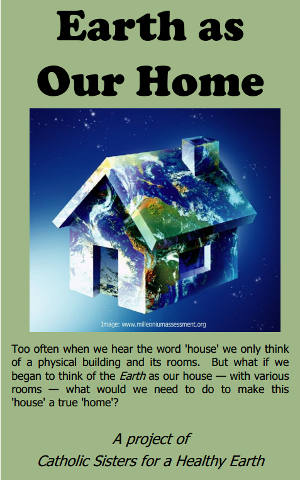
"Earth as Our Home" is a booklet produced by the Catholic Sisters for a Healthy Earth, a collaborative of eight congregations of women religious. (Photo, courtesy of Catholic Sisters for a Healthy Earth)
When is the last time you’ve discovered a “to-do” list that doubles as a great spiritual reading resource?
A recently released free online booklet -- Earth as Our Home -- does just that, offering tips for living more sustainably with the planet. The 16-page illustrated pamphlet comes from the Catholic Sisters for a Healthy Earth, an environmental group comprised of eight women religious congregations.
Sr. Meg Gemar, of the Sisters of St. Francis of Dubuque, Iowa, told NCR that the creation care collective wanted to provide the people in the pews with a simple, reflective tool that connects the idea of their own homes with our shared domicile, Earth. Gemar, one of the eight authors, studied earth literacy at St. Mary of the Woods College, in Indiana.
Presentation Sr. Joy Peterson, the project coordinator, said in a press release that the communities wanted “to take a new look at how everything we do, no matter where we are, is interconnected and tied to the well-being of all living things.” She told NCR so far they have received a lot of enthusiastic feedback from people who have downloaded it and also seen paper copies.
The booklet offers reflections centered in every room of the house -- from the front porch, through the backyard, to the attic -- that instructs and informs how humans manage the household known as Earth. The cover depicts an appealing little dwelling suspended in the starry cosmos, painted in the colors astronauts see from space: marbled blues, greens, whites, browns and yellows.
“What if we were to become aware of Earth as our home?” the booklet’s authors ask. “How would we care for this home differently than we do now? … What would we do differently in managing this larger household?”
Put another way by Henry David Thoreau: “What is the use of a house if you haven’t got a tolerable planet to put it on?”
The subsequent pages feature other quotes from the likes of Pope Benedict XVI, Ecumenical Patriarch Bartholomew I, Ralph Nader and gospel writers Luke and Matthew, and images of mid-American homes reminiscent of the 1940s and ‘50s. In addition, it includes ideas on which to meditate and take action.
Some reflections from the booklet:
Porches offer an opportunity to slow down, to “allow us to partake of nature’s cooling breezes” but also to engage neighbors and others outside our indoor lives.
The garage reminds that “more and more of us are using this space for extra storage instead of for our cars.” It urges us to turn our focus away from what we want to what the world needs. A possible action -- take gently used items to a thrift shop to benefit others in need.
Matthew’s quote about not storing up treasures here on earth sets a theme for attics, and the writers tell us “Earth has no attics for storage. In fact, she has no real ‘away’ for the things we throw away.” That observation prompts us to recycle and repurpose when possible.
The living room becomes the space for family to practice living in community, and to reflect upon plans to recycle, to reduce their carbon footprint, and to help local homeless families.
“How do we view our lawn/yard?” the writers ask, as a showcase of manicured grass and plants, a place where children play, or “Do the sounds and sights of our own lawn fuel our imagination and feed our souls?” Suggestions for actions include installing a rain barrel or butterfly garden, planting shade trees to provide shelter from heat and homes for songbirds, and looking for plants that help provide water retention and add nutrients back into the soil.
In addition to its own reflections, Earth as Our Home encourages readers to go deeper by providing a variety of supplementary resources of books, films and websites. Among them are films “Story of Stuff” and “Nourish”; books The Better World Shopping Guide and The Christian Consumer; as well as a few organizations, such as the Catholic Climate Covenant, and Food and Water Watch.
[Editor's Note: A previous version of this story incorrectly identified Sr. Meg Gemar as part of the Sisters of St. Francis of Clinton, Iowa.]


